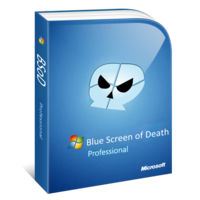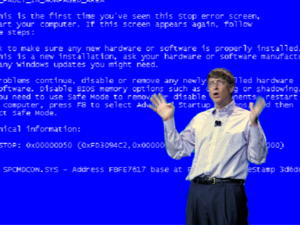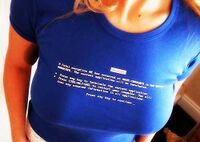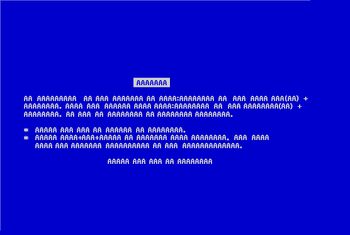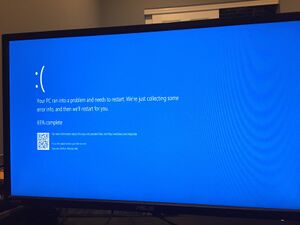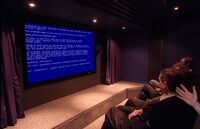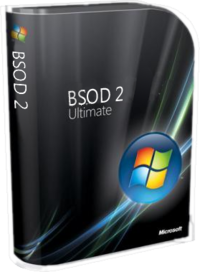Blue Screen of Death
| Blue Screen of Death | |||
|---|---|---|---|
| Publisher | Microsoft | ||
| Release Date | August 24th, 1995 | ||
| Last Stable Release | There never will be | ||
| Genre(s) | Puzzle/Horror | ||
| Mode(s) | Single player | ||
| Platform(s) | Windows 95, Windows 98, Windows NT, Windows ME, Windows 2000... (See complete listing). | ||
| Support status | Currently active | ||
The Blue Screen of Death (abbreviated BSoD or WTFomgBLUESTD), also known as The Blue Screen of Doom, the "Blue Screen of Fun" or "Phatul Exception: The WRECKening", the great blue yonder is an award-winning game first developed in 1995 by Microsoft. Along with HTTP 404 - File Not Found, a hugely successful epic Internet MMORPG developed by Microsoft, the Blue Screen of Death ranks among the greatest computer games of all time. The game simulates a "system error" and displays a series of nonsensical hexadecimal codes for the player to decipher. Since its inception in 1995, BSoD has maintained its position as the most played computer game ever, and is a cornerstone of the Microsoft Corporation.
Origins
The Blue Screen of Death was a concept that Bill Gates had spent a lifetime dreaming about. His vision was for every home and office to have every screen as a blue screen. The Blue Screen of Death was originally going to be sold as stand alone retail software, but the project was canceled amid concerns that profits made from the sale would exceed the total amount of money that could be held on all the banks' computers, which were running Windows 3.11 at the time. This would cause a major crash in Microsoft's bank balance. However, in the July of 1994, with the highly anticipated release of Windows 95 still over a year away, Microsoft executive Charles Simonyi had a vision of including the new game for free with the still-hypothetical operating system, figuring that this would cause a major sales boost, and would coincide with the all the banks computers being swapped out for an Apple Mac to handle the increase in revenue. He decided to include a highly conceptual game which — differing from Microsoft mainstays like Solitaire, Minesweeper and Failing A Network Connection — would actually decide itself when it was to be played, choosing mostly to be played when you are working on something important or masturbating.
Years later in an MSNBC interview, Simonyi admitted that his decision to include the game in the Operating System was fuelled not by a desire for more innovative gameplay, but simply to prove that in a corporation with 70,000 employees, Bill Gates does not make each decision the public finds unpalatable.
Developing the Game
In the year leading up to the release of Windows 95, Simonyi toiled to get his dream released. Inspired by the initial success of its MS-DOS single-player RPG predecessors Bad Command or File Name and Abort, Retry, Fail?, Simonyi decided that future games should paralyse the entire computer, forcing the player to restart his PC during the course of the game so as to enhance the element of realism and active player-involvement in the game. In the first six months, he divided his time between sleeping, taking vacations, collecting massive paychecks, worrying about being "too rich", donating several thousand dollars to a random charity, spending several weeks demanding recognition for said donation, yelling at the TV whenever a rich Russian got into space, correcting mispronunciations of his last name, and living a far, far more extraordinary life than you ever will. Then, via e-mail, he told his assistant to hire some guys.
The newly formed group of programmers (unofficially dubbed "Inadvertent Games", but who have been given other monikers far too impolite to publish here) set about to fulfil Simonyi's dream. And another six months and 46,000 kernel add-ons later, the game was revealed to the public.
Reception
The Blue Screen of Death was an instant success the moment it hit the shelves, exceeding all expectations of Microsoft market analysts and freelance Wired "journalists". The Bureau of Convenient But Factually Replete Statistics (BCBFRS) estimated that at least 250,000 Windows users played at least 6 non-concurrent games of BSoD within a week of purchasing the system, and that another 140,000 users played the game in the middle of system installation. As news of the popularity of the game spread through the Microsoft offices, developers were quick to release game patches to the public which varied the frequency of BSoD puzzles, as well as the difficulty of deciphering the hexadecimal error messages contained within them.
Windows 98: A New Way To BSoD
Despite the frequency with which these patches were released, Windows users finding themselves hungry for more opportunities to play BSoD, and the some of the later patches released actually had users playing the game less. It occurred, to one of Simonyi's assistants, that a new operating system would have to be made to fill this need.
It so happens that meanwhile, Microsoft's Chief Media Analyst Pølski Fakenameovich was also lobbying for a new Windows release. Fakenameovich, relying heavily on data from the BCBFRS, believed that the public was clamouring for a new Windows operating system, and so delivered a rousing speech to Microsoft Executives' administrative assistants. "What the public needs, he theorized, "is an Operating System which looks like Windows 95... but which performs like Windows 95." But despite his strong words, exaggerated hand gestures, and promise of free drinks (bottom or mid shelf only) to anyone who listened to his full speech, the speech fell on deaf ears. It also fell on the ears of people in the room who could hear, because they were more cautious than Ernie around bottle rockets. Disheartened but resolute, Fakenameovich continued his work, until a chance meeting changed his life forever.
The Chance Meeting Alluded To
Fakenameovich confided in Simonyi's assistant his difficulties with the current Windows operating system and she mentioned that Simonyi too was having reservations about Windows 95, or that at least she perceived that he was, since he had complained that he was four strokes over par the previous week, and couldn't figure out what was screwing his game up. So, he had sex with a penguin, which fixed everything.
Emboldened by the news and half-numb from the slap he had just received, Fakenameovich furiously typed out an e-mail to the unhomely Microsoft executive. He reiterated the words exchanged (mostly) between himself and Simonyi's assistant and addressed his belief in a need for a completely new operating system which was totally the same. A week later, Fakenameovich got his response:
- I'm in Bali. Do whatever the ---- you want.
- XO,
- Charlie
With that, Fakenameovich teamed up with the Inadvertent Games group and the project was under way.
BSoD Integration
The integration between Windows 95 and the Blue Screen of Death was heralded by Rolling Stone Magazine's Greil Marcus as "a seamless integration between operating system, and game which the operating system has commanded I play" in an issue which also heralded the movie as Evita as "not that bad", but they were right about the former. The handling of BSoD on Windows 98 is widely viewed as "the best" yet, and in 1999 BSoD was even more widely played by computer users everywhere.
Windows 2000 & Beyond
The release of Windows 2000 marked a slowing in development for BSoD. With the rise of the internet, Windows users were now tempted to cheat, and find out what the fatal exception error hexadecimals meant, and with this wealth of information began the Great Numberology Depression of 2001. BSoD was being phased out in favor of Windows 2000's newly packaged game: Security Flaws, and Windows XP's blockbuster sequel Click the X on the speech bubble that comes out of the Start Bar.
In this "beta version" of the game, unintelligible messages appeared in the form of yellow boxes at a rate much higher than the original BSOD game. However, diehard fans were extremely disappointed by the loss of their beloved hexidecimal numbers and the lack of sensible options. As a result, Microsoft promised that the next version (which would later appear in Vista) would have popup bubbles that do nothing whatsoever, even when clicked. However, new technology, old software, and the proliferation of blinking lights assures that BSoD's history has yet to be written.
Windows 8, 9, and 10
Due to how scared people could get when they see the BSoD on Windows 7 and earlier, Microsoft decided to evolve the BSoD to make it look more futuristic and less scary. This change started when Windows 8 was released. It showed a sad face, hoping that it would explain to people that the BSoD is infuriating to other people too. It also showed more easier to understand information so that those who aren't tech-savvy can understand the error better. Due to the fact that Windows 9 was full of too many glitches, the BSoD showed very often, and therefore discontinued.
Possible Future Multiplayer Support
Ever since its first release, Microsoft has promised to release a future version of BSoD with muti-player capabilities over the Internet. Beginning with Windows XP and 2000, Microsoft released a windowed , as opposed to the normal full-screen, version of BSoD. The signature blue screen was replaced with a Windows error dialog box masquerading as Windows Error Reporting, whereby Windows connects the user to the Microsoft database in a convincing but ultimately fictitious attempt to archive the error for future reference. The Microsoft error report database is actually a server with a 128byte hard drive to reduce the complaints they get thus raising their satisfaction levels. Windows help made it so that people with little to no experience with computers could fix their simple computer errors in a record breaking time usually no less than 10 hours.
At present the only BSoD multi-player feature supported is the Hot Seat, whereby two players share a computer, taking turns each time to see who can generate more BSoDs in the space of five minutes.
How To Play BSoD
The rules for BSoD are elegantly simple. Unlike most standard computer games, where players launch a computer game to play, BSoD is unique in that the game itself determines when it should be played. Hence to play BSoD, one should use the computer as normal, preferably while working on important documents on Microsoft Office applications without saving your work. It is known that such "pre-game" preparation would enhance the players excitement and enjoyment upon encountering a BSoD. BSoD-enhancing applications, typically those which consume a lot of system resources such as Battlefield 2142 or Half-Life 2 have also been known to increase the likelihood of a BSoD appearance, but most players prefer to start the game by creating a long Microsoft Word document. The game has also been known to start even if in the absence of active use of the computer, which is of course, not as exciting.
Once you see the screen, the game has begun, and that means that you have to try to decipher a bunch of random error codes that everybody but you know what mean! The objective is to try to fix the BSoD and not let it frustrate them to the point of them quitting! Upon the game's beginning, BSoD players are expected to stare at the screen with their head in their hands, trying to remember the last time they saved their work. More rambunctious players (known as "BSoD hooligans") have been known to smash their monitors and computer cases in misdirected excitement.
Options Confusion
Some users have found themselves confused at BSoD's "instant win architecture", and the appearance of "options" on the screen itself. The options are actually a façade, meant to appeal to users familiar with games like Zork and who crave interaction in their interactive games. The first option given, "press any key to terminate the current application", is there for appearances only, as pressing the spacebar to terminate the current application only paves the way for the user to press the spacebar 50 more times in frustration. The second option, "Press CTRL+ALT+DEL again to restart your computer [something about losing data]", is actually the only correct and viable option, unless that doesn't work, in which case users are encouraged to use the Power Button Game Accessory packaged with many computers.
Criticism
Obviously, there are some criticisms about the game. This includes users complaining that it does not support Xbox 360 controllers and even basically, a mouse. Therefore, Microsoft is releasing BSoD 2.0 Deluxe Edition which includes extra gaming devices, enchanced blue so that users would not go blind if staring at it for too long and some bug fixes. That is, optimizations of said bugs.
See also
- Detect "non-genuine" products
- Gather user information and credit card numbers
- Cripple core system components
- Deploy legal team
- Launch civil litigation
Estimated time remaining:
Forever, or if you give me a cookie, I might shorten it to an hour.
Installing Windows has never been easiereasy
All you need to do is phone your local Microsoft Customer Representative, write down a very long set of numbers, type it all in, get an error message, phone our Customer Representative again, adjust a few things, get another very long set of numbers, type it all in again, install a few drivers, activate Windows again, lather, rinse and repeat.
Related technology:
- Apple
- MS-UNO
- MS-DOS
- .NET
- Blue Screen of Death
- Calculator
- CTRL-ALT-DEL
- DirectX
- Hotmail
- Internet Explorer
- UnNews: Microsoft unveils Internet Genuine Advantage
- Microsoft Products Online Technical Support
- Microsoft Access
- Microsoft Keyboard
- Microsoft Office
- Microsoft Outlook
- Microsoft Surface
- MS Paint
- PowerPoint
- MS Word
- Microsoft Word Paperclip
- Minesweeper
- MSNBC
- Notepad
- Registry Editor
- Total Fucking Asshole Server 2006
- Microsoft Immortal Life Support System
- Task Manager
- Windows X-Console
Windows Product line:
- Windows
- Windows BC
- Windows 1.0
- Windows 3.1
- Windows 95
- Windows 98
- Windows NT
- Windows Me
- Windows You
- Windows 2000
- Windows XP
- Windows Server 2003
- Windows Vista
- Windows Vista Pirated Edition
- Windows 7
- Xbox
- Windows 2010
- Windows for Politicians
- Windows Error Edition
- Windows 8
- Windows 9
- Windows 10
- Windows 11
| Featured version: 23 August 2007 | |
| This article has been featured on the main page. — You can vote for or nominate your favourite articles at Uncyclopedia:VFH. | |
